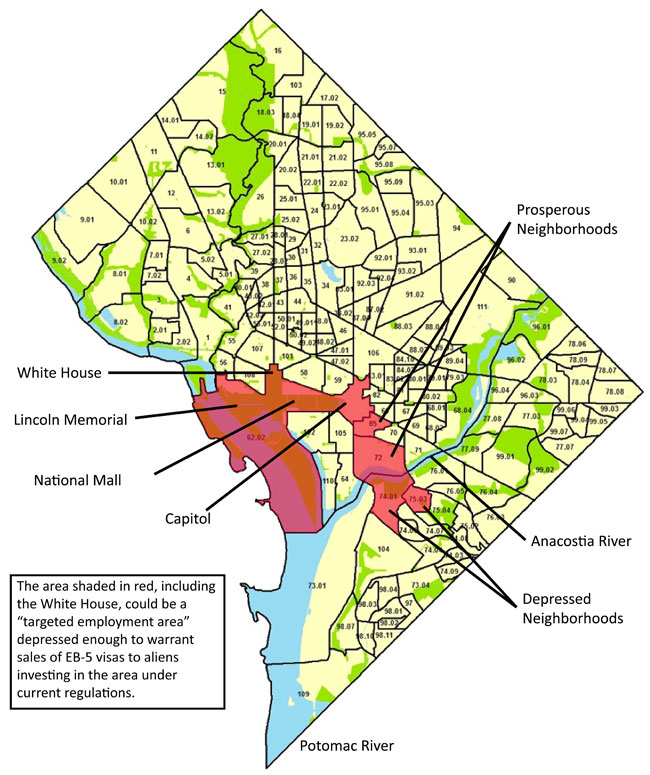The old rules for defining a depressed area where EB-5 investments could be made were loose enough, as we pointed out with a map illustration back in 2013, so that a potential immigrant with $500,000 to invest could get a set of green cards for his or her family by making such an investment in real estate across the street from the White House, on the grounds that the neighborhood (as defined under those rules) was "economically depressed".
Clearly this is one of the more elegant, non-distressed neighborhoods of the nation. But with a little time and imagination my editor (Patrick McHugh) and I devised a strung-out series of census tracts that collectively had an unemployment rate higher than 150 percent of the national average, and was thus eligible for EB-5 projects, even though the White House was part of the area.
That imaginary Targeted Employment Area (TEA), the code phrase in EB-5 speak, looked like this:

The EB-5 program makes it possible for an alien investor to get a full, family-sized set of green cards for investing in a Department of Homeland Security-designated, but not guaranteed, project if the investor puts up $900,000. Before a change in the rules the minimum investment had been $500,000.
The new rules, as of last year, not only lifted the amount of the investment, they made the definition of a TEA more rigorous and less likely to be economically gerrymandered. However, the new rules are not that much stiffer than the old ones, so that the old oddity – the White House is in an economically-depressed area – still holds, as I discovered to my surprise the other day.
EB-5 Affiliate Network has created a nifty application that allows you to type in an address, apparently anywhere in the US, and it will tell you immediately if this area is clearly in a Targeted Assistance Area (a depressed one where an investment of the right kind would lead to set of green cards), or where it might be eligible in the future but not now, or if the area is clearly not eligible. Its labels for the three levels are "Success!", "Uncertain!," and "Try Again!"
The app looks at the unemployment levels in the recent past for both the census tract of interest, and all those adjacent to it, and then it pairs the first tract to one or more others to see if it can create an eligible TEA out of what is had found.
In the case of the White House here's the math that shows that the area at the time of this writing qualifies for the designation under the current regs:
|
The White House is in an EB-5 Qualified Targeted Employment Area (TEA) |
||||
|
Tract |
Civilian Labor Force |
Employed |
Unemployed |
Unemployment Rate |
|
Tract 62.02 (the White House) |
58 |
58 |
0 |
0% |
|
Tract 108 (nearby) |
2,538 |
2,327 |
221 |
8.7% |
|
Combined Area |
2,596 |
2,375 |
221 |
8.5% |
|
|
|
|
Qualifying Rate |
8.0% |
|
Source: EB5 Affiliate Network using the "ACS method". |
||||
If you look carefully at the illustration you can see that Tract 108 is just west of the White House and was not in the gerrymandered TEA that we at CIS had created back in 2013. Either we overlooked the possibility or the numbers at the time would not have warranted a TEA made of the two tracts.
While much of Tract 108 consists of office buildings it also covers all or part of George Washington University, and some students may have been caused the unemployment statistics.
One can play with this software for hours; we decided to check out just four luxurious neighborhoods to see if any of them qualified for a depressed designation and one clearly depressed one in West Virginia. This is what we found, using the categories offered by the app:
|
Landmark |
Address |
EB-5 TEA Rating |
|
Mingo County Courthouse in the coal fields of W.Va. |
74 E Second Ave., |
Success! |
|
The Plaza Hotel, NYC |
768 Fifth Ave., |
Uncertain! |
|
The Trump Tower, NYC |
725 Fifth Ave., |
Uncertain! |
|
The Beverly Hills Waldorf Astoria (once EB-5 funded) Beverly Hills, Calif. |
9850 Wilshire Blvd., |
Uncertain! |
|
French Ambassador's house in Washington, D.C.; |
2221 Kalorama Road NW, |
Try Again! |
My sense is that the "Uncertain" category is often applied, in this app, to neighborhoods that are unlikely ever to be qualified for a TEA designation. It is good news that the fancy hotel in Beverly Hills would not qualify now for EB-5 funding as it did in the past. Places like Williamson, W.Va., should be getting the EB-5 funding; that's unlikely, though, even with the new regulations.
